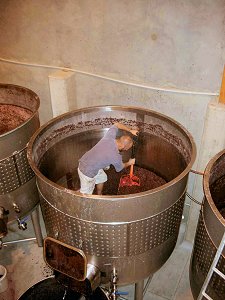Rodney Strong: some changes
Rodney Strong invests $5.5 million in bottling line, winery
(NBBJ, by JEFF QUACKENBUSH, 3/6/06)
"...The new line will be operational by late March. Journey Bottling Co. of Santa Rosa has been operating an 80-bottle-per minute mobile line there since January to ease the transition. The winery will be gradually increasing production by 150,000 cases a year to 750,000 cases in the next several years. ...
On the winery side of Rodney Strong, winemaker Gary Patzwald is carving 12,000 square feet out of the barrel cellar for a $2.8 million winery-within-a-winery program. During the 2005 harvest, he selected parts of rows and lots for the best Bordeaux variety clones, soil and sun exposure (about 1 brix of sugar content higher than the average for other fruit) in the winery's estate vineyards and had them picked in the half-ton bins.
The fruit was sorted by a P&L Specialties Le Trieur shaker-sorter then manually by six to eight workers. It then went through presses at two to three tons an hour, five times slower than normal, and into five- to eight-ton fermenters. When the small-lots program is fully operational in July, it will have 60 tanks.
The inaugural wines of the program aren't named yet. They'll be in barrels for 18 to 20 months then sit in bottles 10 to 12 months before release in early 2008."
That's apretty labor intensive system. Patzwald was most recently winemaker at Matanzas Creek, and before that was a winemaker for Kendall-Jackson. I believe he had brought a similar picking/fruit sorting table and small tank fermentation system into play at K-J about a decade ago. It should be interesting to collect a vertical of Rodney Strong reds and see what comes of the changes.
One of the important factors in this kind of change is the style of the fermenting tanks installed. Normally tanks have a slightly thinner and taller profile than may be desired for red wines - what you might call a "general purpose" wine tank. By purchasing tanks specifically for small red fermentations, one can have them made a bit more squat and wide. That allows for a larger surface area of the wine to come into contact with the pomace - and thereby increases the extraction efficiency (more intensity, color, etc).

(This is the classic "open top" red fermentor: squat and wide, designed for plenty of extraction. Notice the dimpled cooling jacket on the exterior to help control fermenting temperatures. The wide door on the bottom is another hint that this tank was designed for reds; you need a larger opening to get a man inside to shovel out the red pomace. One big drawback is the inability to store wine in this tank type - without a top to keep air out, oxidation can happen quickly...)
Conversely, tanks for white fermentation don't need to be made with an eye for contact with pomace, so generally they're tall and thinner than red fermentors. This also decreases the surface area exposed at the top of the tank where oxidation usually takes place - reducing the chances that your white wine will go bad.
 (This tank was constructed in more of a "white wine" configuration - tall and relatively thin- even though it appears to be an "open top" tank...which whites aren't kept in for oxidation reasons. Again notice the cooling jackets for temp control, and the smaller door because no one will need to go inside the tank to shovel pomace out. Clearly the door isn't set up for a red fermentor... )
(This tank was constructed in more of a "white wine" configuration - tall and relatively thin- even though it appears to be an "open top" tank...which whites aren't kept in for oxidation reasons. Again notice the cooling jackets for temp control, and the smaller door because no one will need to go inside the tank to shovel pomace out. Clearly the door isn't set up for a red fermentor... )


0 Comments:
Post a Comment
<< Home